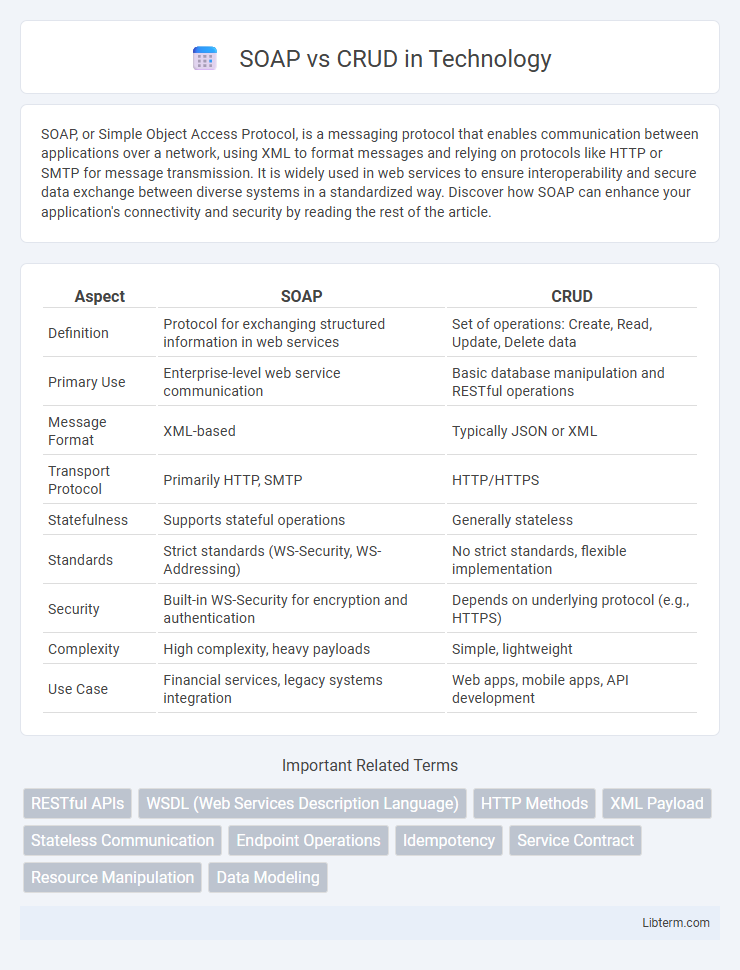SOAP, or Simple Object Access Protocol, is a messaging protocol that enables communication between applications over a network, using XML to format messages and relying on protocols like HTTP or SMTP for message transmission. It is widely used in web services to ensure interoperability and secure data exchange between diverse systems in a standardized way. Discover how SOAP can enhance your application's connectivity and security by reading the rest of the article.
Table of Comparison
| Aspect | SOAP | CRUD |
|---|---|---|
| Definition | Protocol for exchanging structured information in web services | Set of operations: Create, Read, Update, Delete data |
| Primary Use | Enterprise-level web service communication | Basic database manipulation and RESTful operations |
| Message Format | XML-based | Typically JSON or XML |
| Transport Protocol | Primarily HTTP, SMTP | HTTP/HTTPS |
| Statefulness | Supports stateful operations | Generally stateless |
| Standards | Strict standards (WS-Security, WS-Addressing) | No strict standards, flexible implementation |
| Security | Built-in WS-Security for encryption and authentication | Depends on underlying protocol (e.g., HTTPS) |
| Complexity | High complexity, heavy payloads | Simple, lightweight |
| Use Case | Financial services, legacy systems integration | Web apps, mobile apps, API development |
Introduction to SOAP and CRUD
SOAP (Simple Object Access Protocol) is a standardized protocol for exchanging structured information in web services, relying on XML for message format and usually operating over HTTP or SMTP. CRUD represents the core operations of persistent storage in computer systems: Create, Read, Update, and Delete, essential for database management and RESTful services. SOAP emphasizes formal contracts through WSDL for interaction, while CRUD is centered on resource manipulation in data-driven applications.
Core Concepts of SOAP
SOAP (Simple Object Access Protocol) relies on XML-based messaging to enable communication between distributed systems, emphasizing a strict contract defined by WSDL (Web Services Description Language). Core concepts of SOAP include its use of envelopes to encapsulate message data, mandatory headers for defining message context, and fault elements for robust error handling. Unlike CRUD operations that focus on data manipulation through HTTP verbs, SOAP structures interactions as predefined operations with complex messaging patterns.
Fundamentals of CRUD Operations
CRUD operations represent the fundamental concepts of data manipulation: Create, Read, Update, and Delete, essential for database management and application development. SOAP, or Simple Object Access Protocol, is a protocol for exchanging structured information in web services, often implementing CRUD functionality through standardized XML messaging. Understanding CRUD fundamentals enables developers to effectively design and interact with SOAP-based services, ensuring reliable data processing across distributed systems.
Architectural Differences Between SOAP and CRUD
SOAP (Simple Object Access Protocol) operates as a protocol designed for exchanging structured information in web services, emphasizing strict messaging standards, XML-based envelopes, and enhanced security features like WS-Security. CRUD (Create, Read, Update, Delete), typically implemented through RESTful APIs, follows an architectural style that maps operations directly to HTTP methods (POST, GET, PUT, DELETE), promoting stateless communication and resource-oriented design. The architectural difference lies in SOAP's rigid contract-first approach with built-in error handling and stateful operations support, contrasting with CRUD's flexible, resource-centric, stateless interactions optimized for web scalability and simplicity.
Protocols and Standards Involved
SOAP (Simple Object Access Protocol) relies on XML-based messaging protocols with strict standards such as WS-Security for secure communication and WSDL for service description, ensuring formal contracts between client and server. CRUD (Create, Read, Update, Delete) operations typically use RESTful principles which are protocol-independent but most commonly leverage HTTP methods (POST, GET, PUT, DELETE) and support multiple data formats like JSON and XML. SOAP enforces a rigid structure and uses extensive standards for transaction reliability and security, whereas CRUD combined with REST embraces lightweight protocols promoting flexibility and scalability.
Data Formats and Communication Methods
SOAP relies on XML as its primary data format, ensuring strict message structure and extensive standards for security and transactions, which makes it suitable for complex enterprise-level applications. CRUD operations typically use RESTful APIs that support multiple data formats, including JSON and XML, allowing more flexibility and easier integration with web technologies. SOAP uses a standardized envelope for message communication over protocols like HTTP, SMTP, or TCP, while CRUD in REST commonly uses simpler HTTP methods (GET, POST, PUT, DELETE) directly for resource manipulation.
Security Considerations
SOAP employs built-in security standards such as WS-Security, enabling message-level encryption, digital signatures, and authentication mechanisms that provide robust protection for sensitive data in transit. CRUD operations over REST typically rely on transport-layer security like HTTPS and may require additional application-layer security implementations to ensure proper access control and data integrity. SOAP's extensive security specifications make it better suited for enterprise applications demanding stringent security compliance and message confidentiality.
Use Cases and Practical Applications
SOAP excels in enterprise-level applications requiring strong security, ACID compliance, and complex transactions, such as payment gateways, telecommunication services, and financial systems. CRUD operations suit web applications and RESTful APIs focused on straightforward data manipulation, including content management systems, user profile management, and inventory tracking. Practical applications favor SOAP when message reliability and formal contracts are critical, while CRUD fits scenarios demanding simplicity and scalability.
Performance and Scalability Comparison
SOAP APIs typically offer robust performance through standardized protocols like HTTP and XML but may experience higher latency due to message complexity, impacting scalability under heavy loads. CRUD operations, often implemented via RESTful APIs, provide lightweight interactions using JSON, resulting in faster response times and easier horizontal scaling. Choosing between SOAP and CRUD hinges on the specific application's need for transactional integrity versus rapid, scalable data manipulation.
Choosing the Right Approach: SOAP or CRUD
Choosing between SOAP and CRUD APIs depends on the complexity and security requirements of your application. SOAP offers standardized protocols and built-in security features suitable for enterprise-level integrations and transactions requiring strong security and reliability. CRUD APIs, using RESTful principles, provide simplicity and flexibility for resource manipulation in web and mobile applications with faster development and scalability.
SOAP Infographic

 libterm.com
libterm.com